
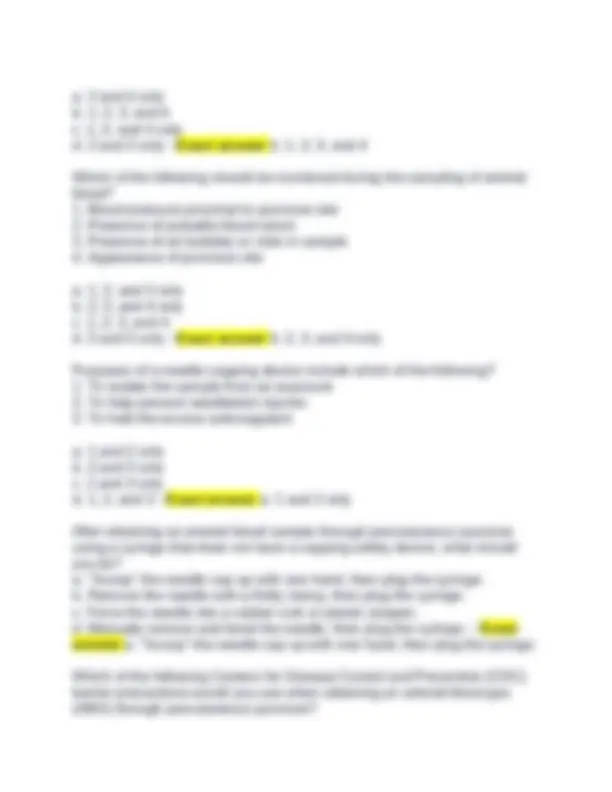
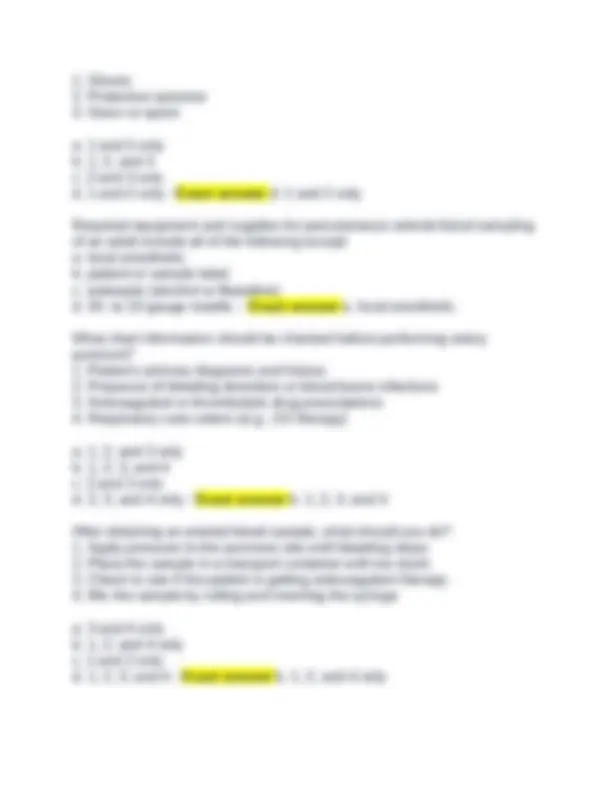
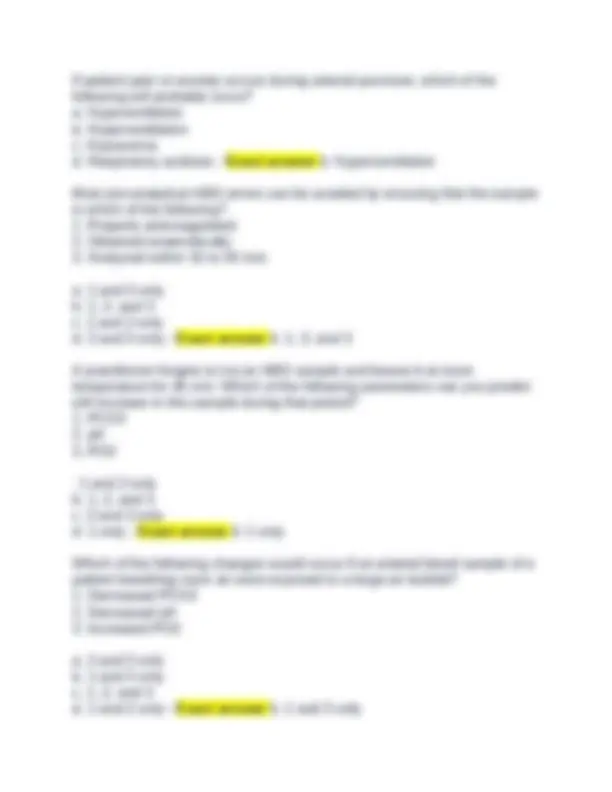
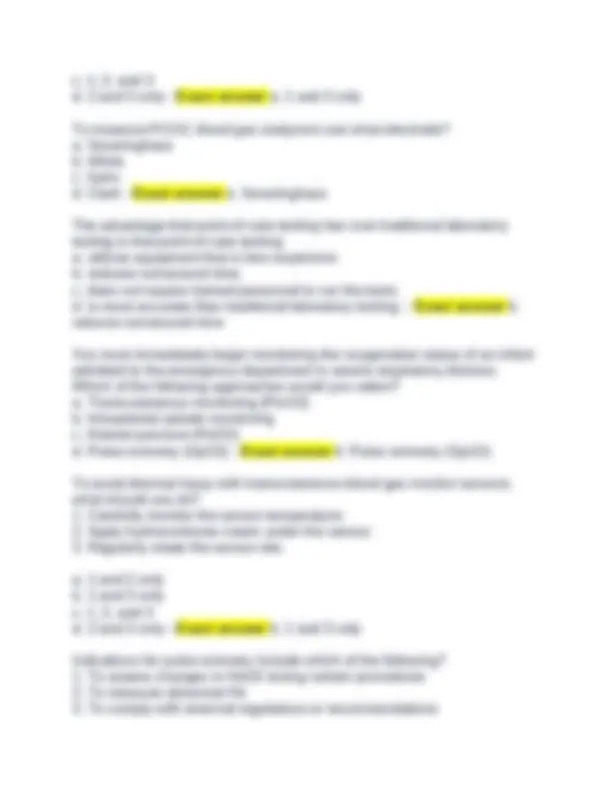
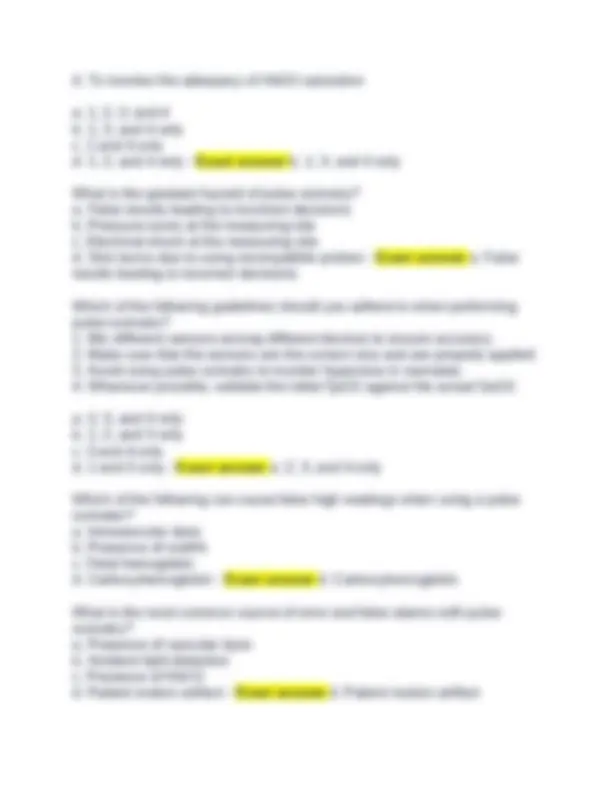
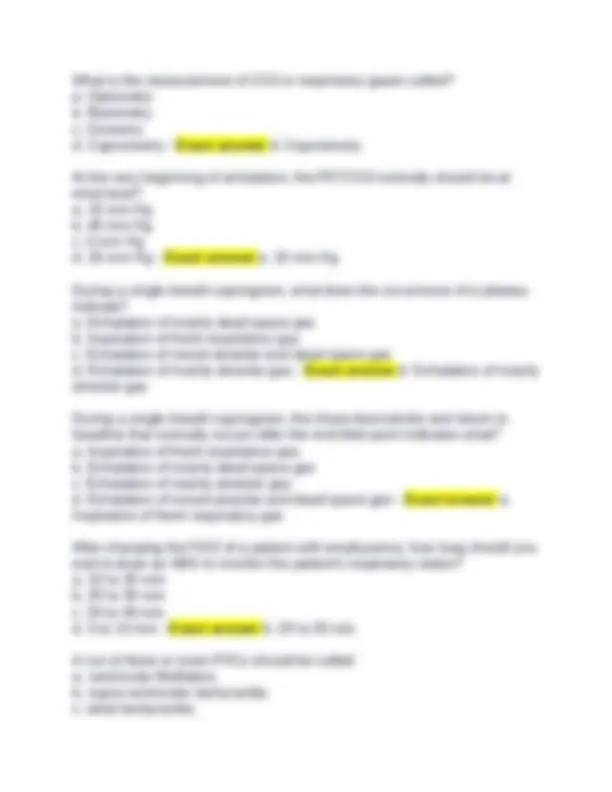
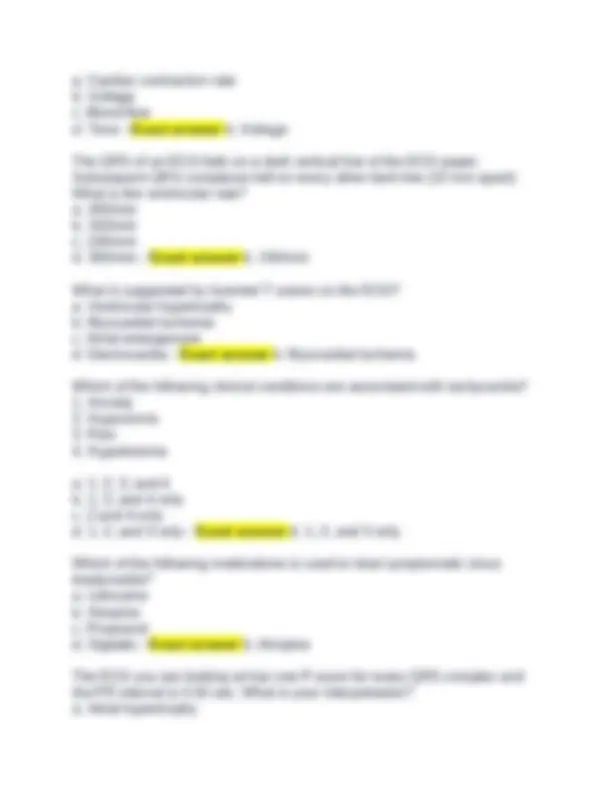
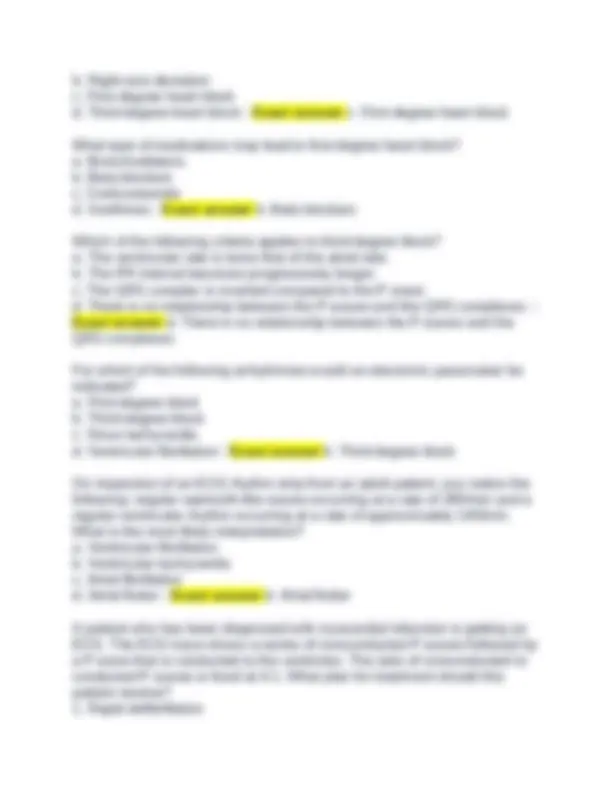
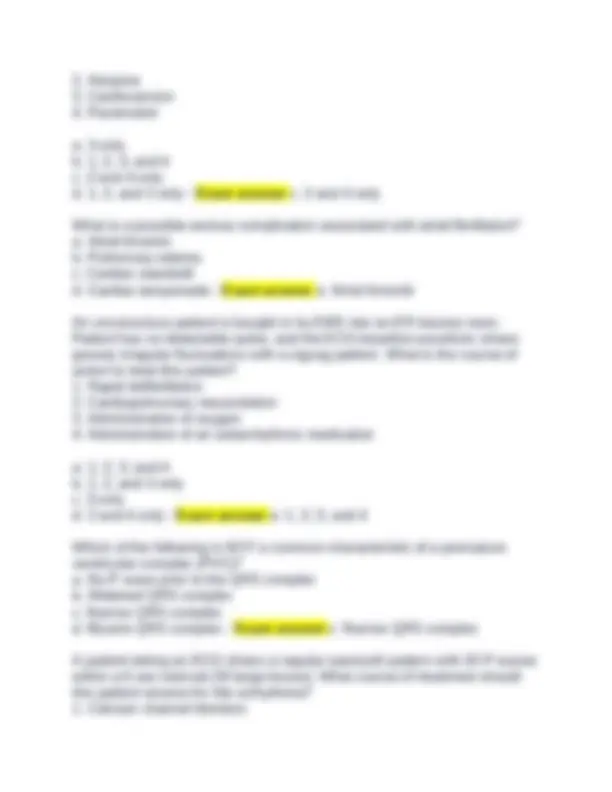
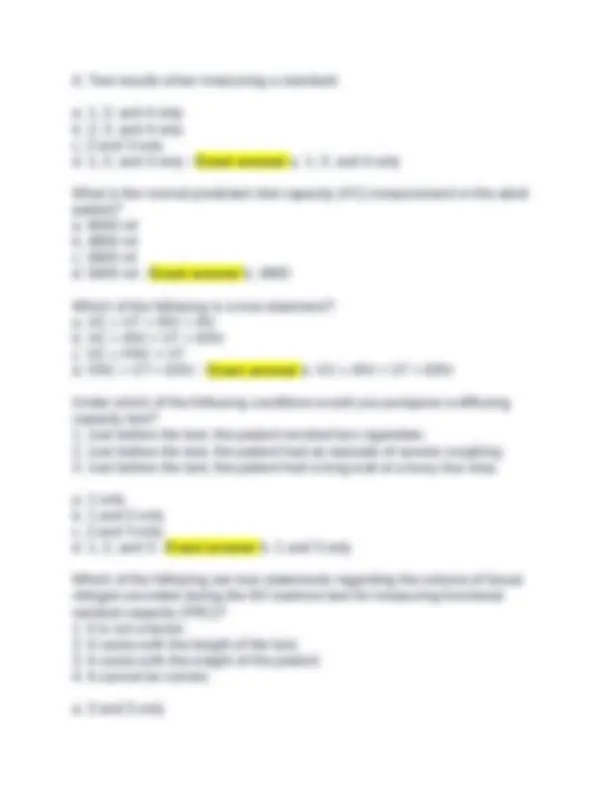
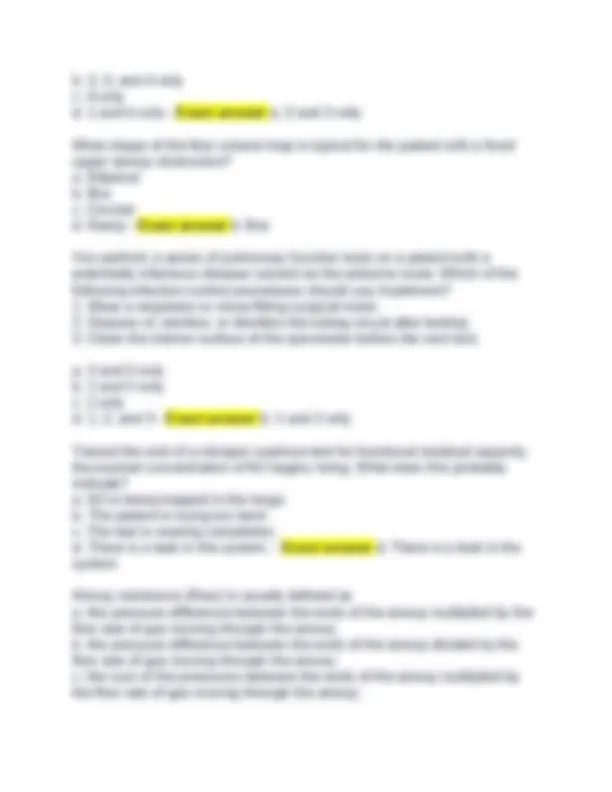
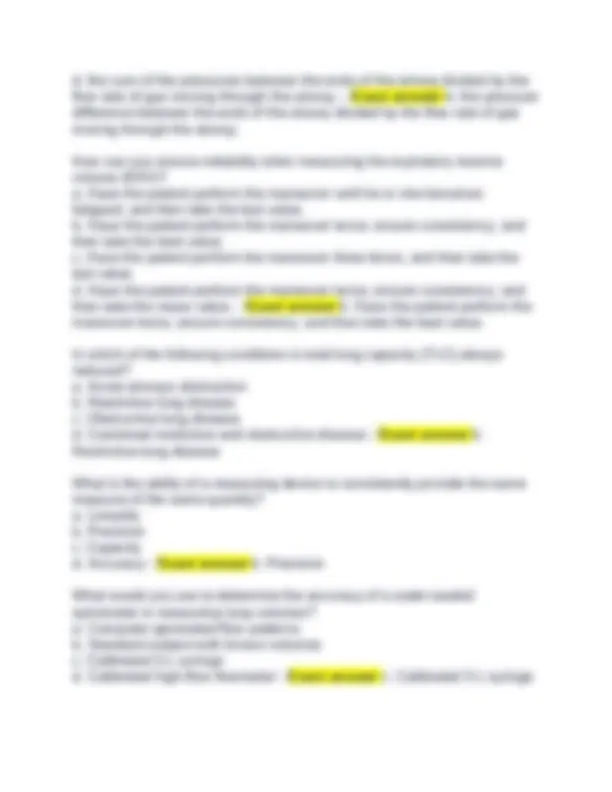
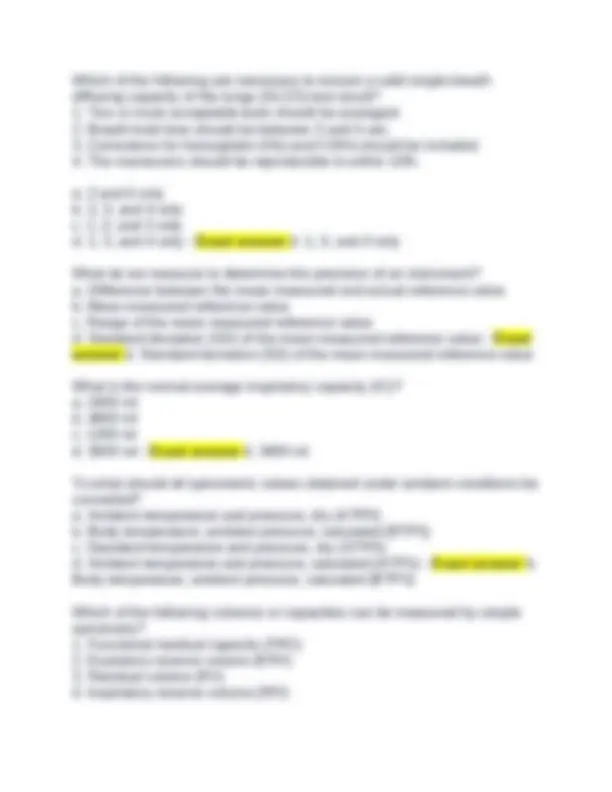
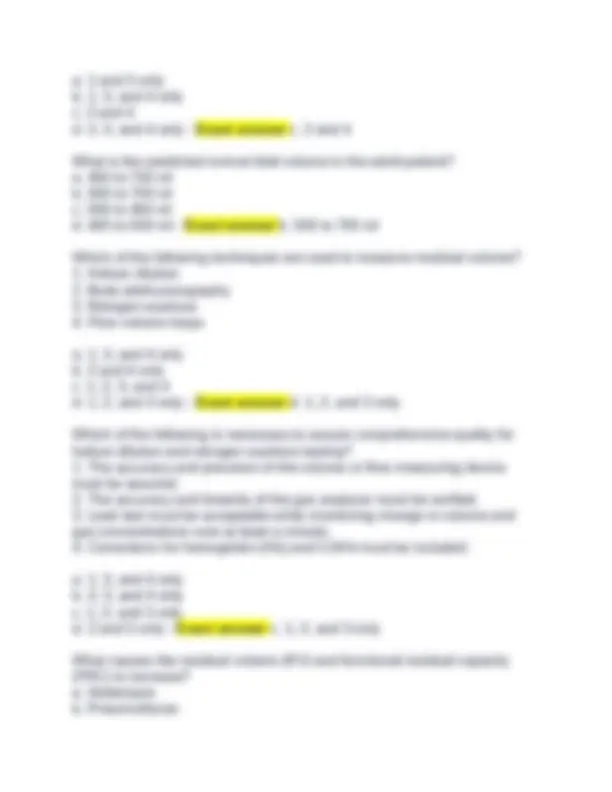
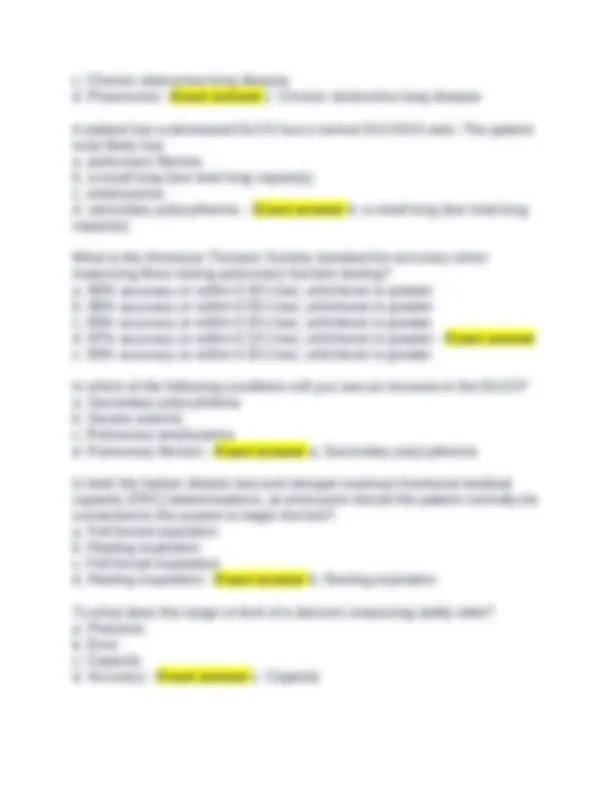
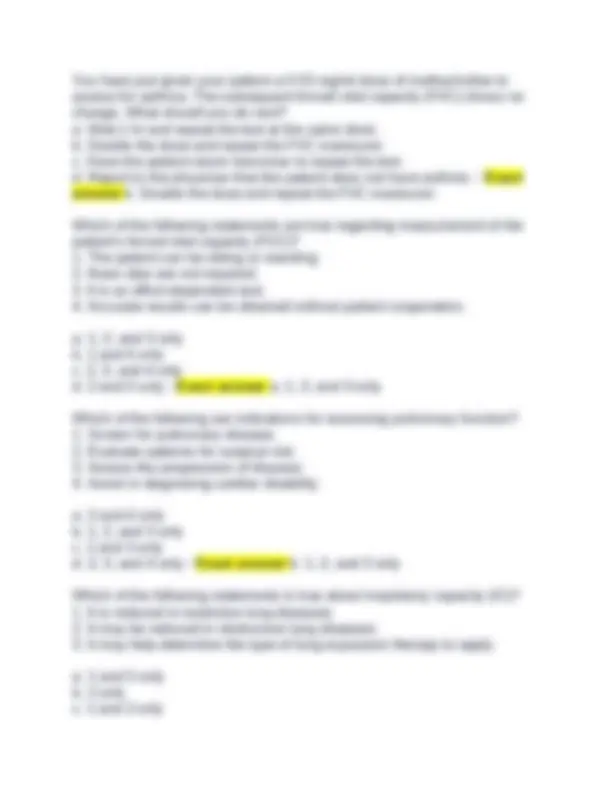
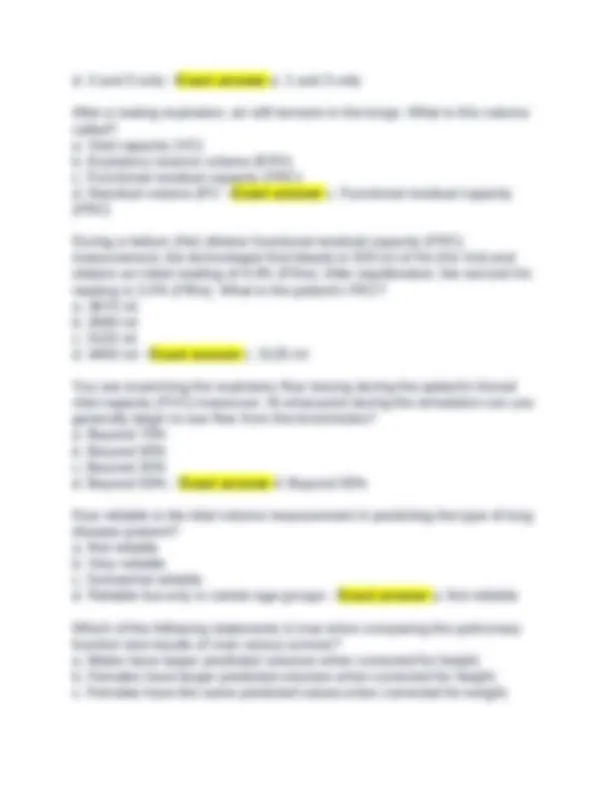
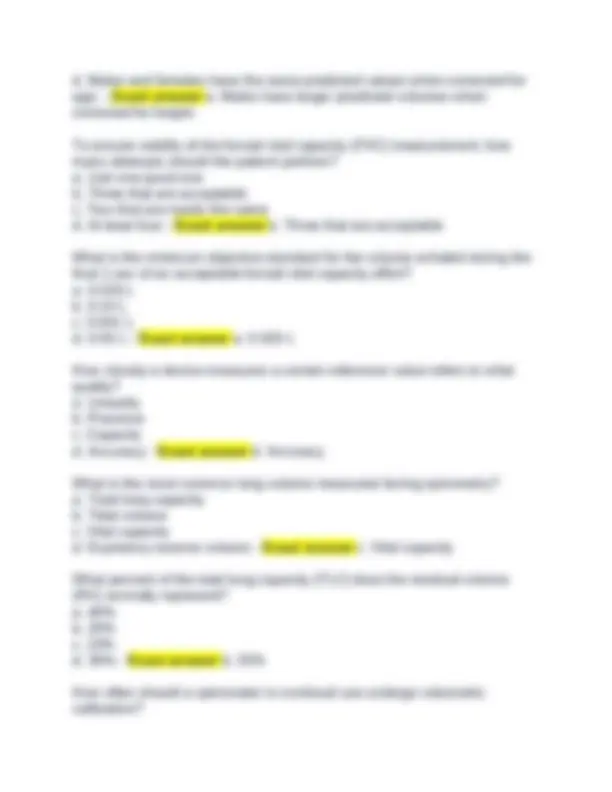
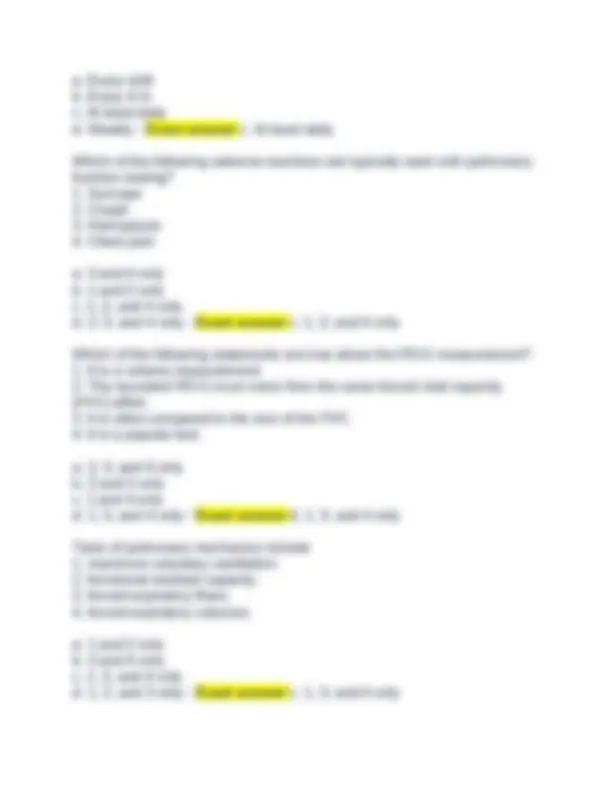
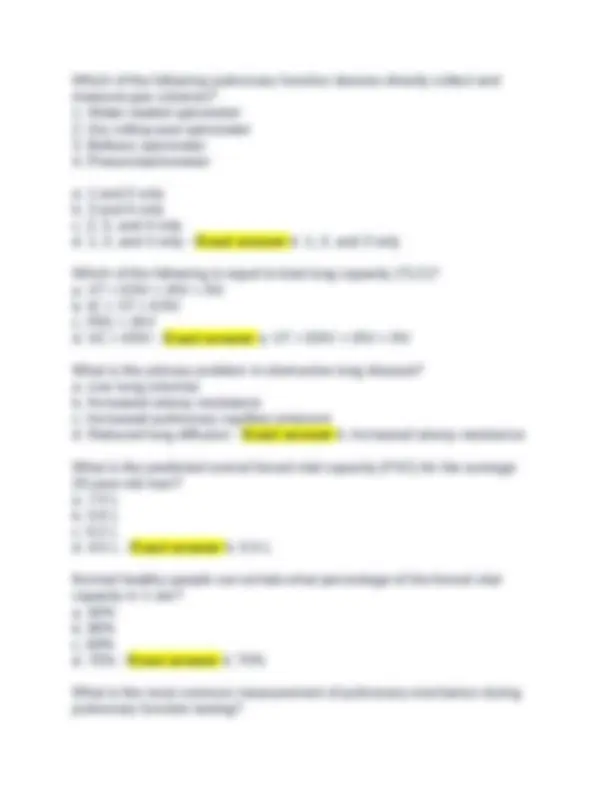
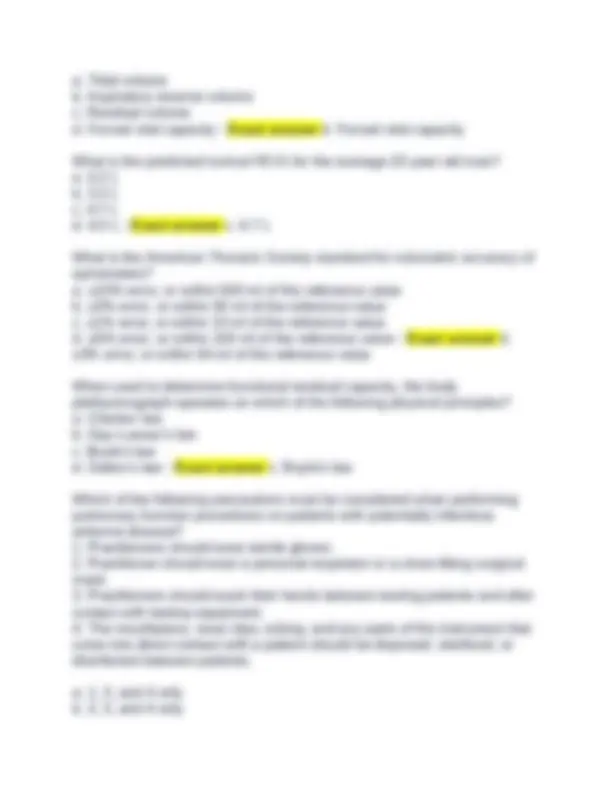
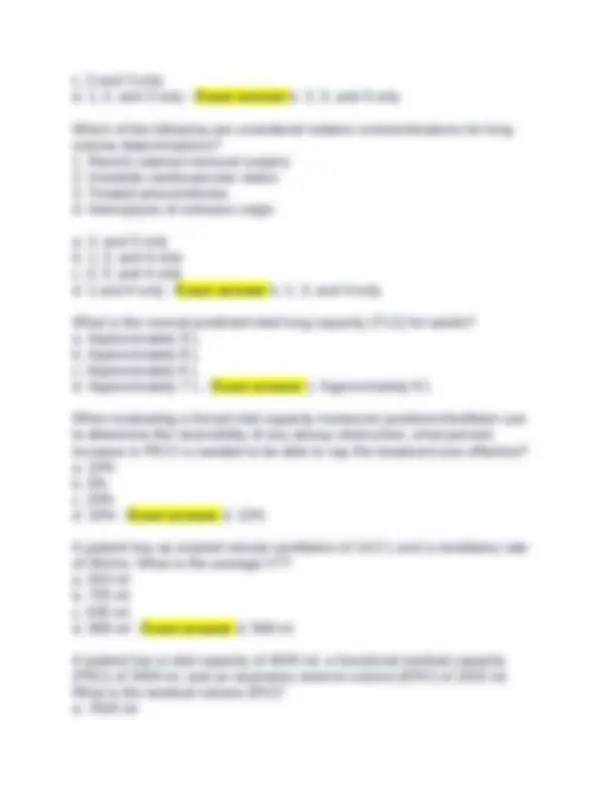
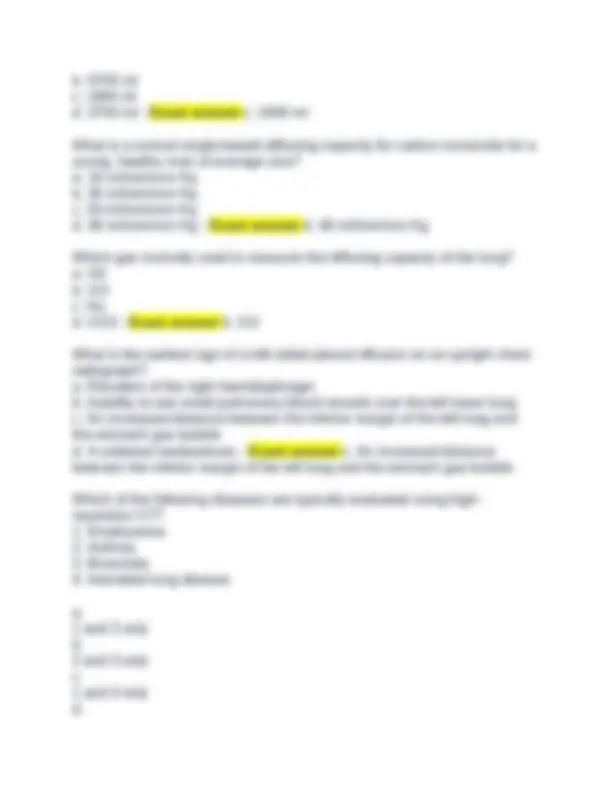

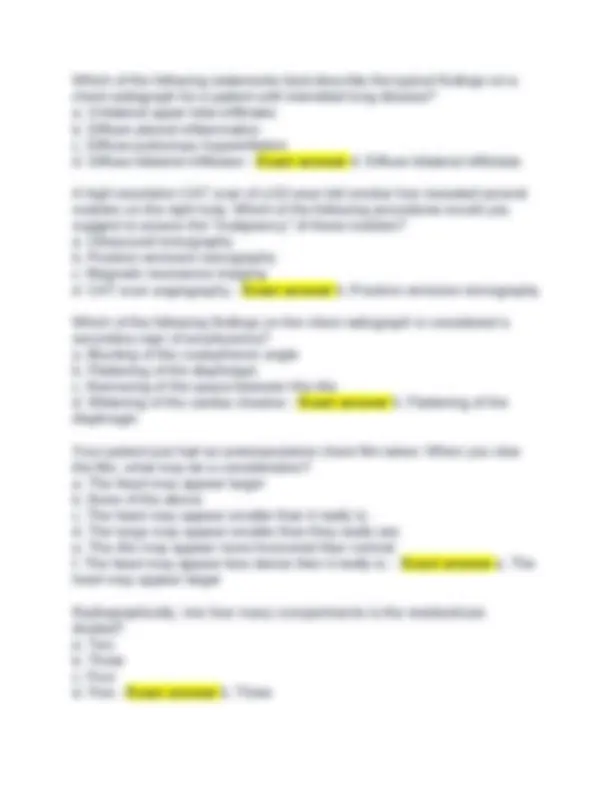
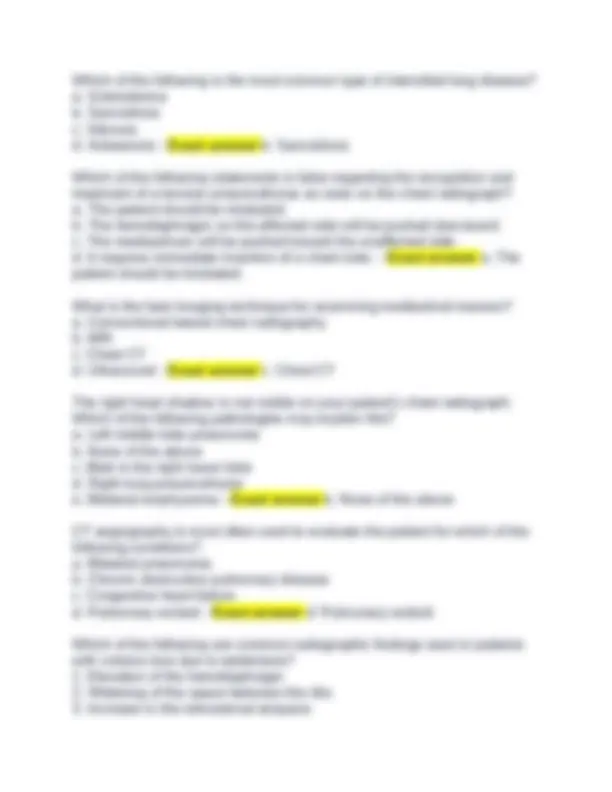
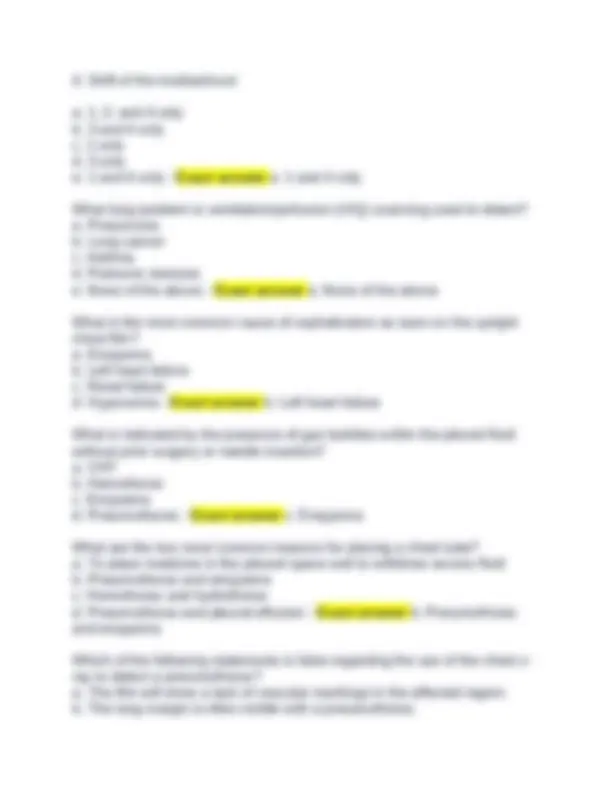
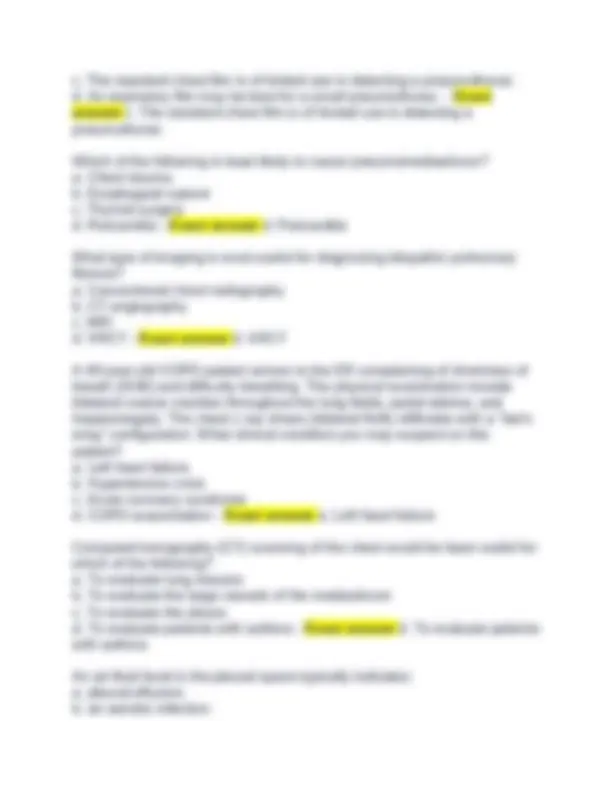
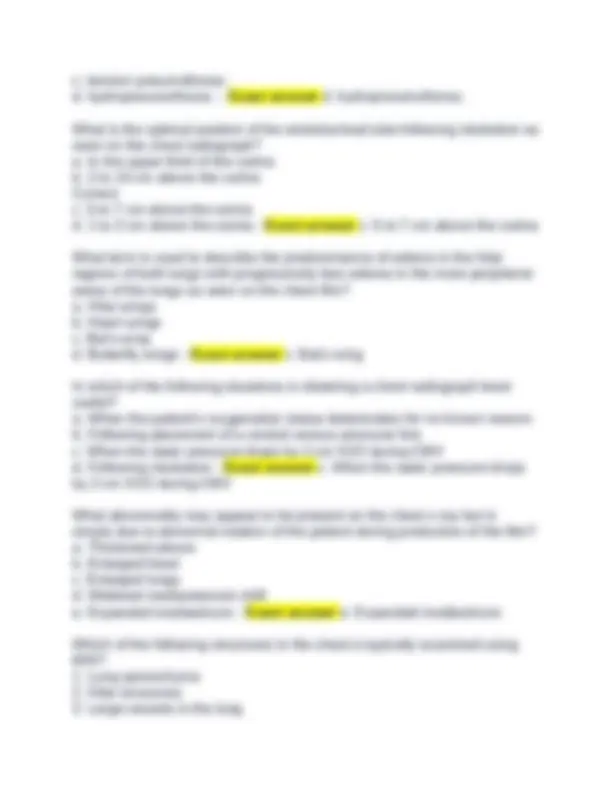
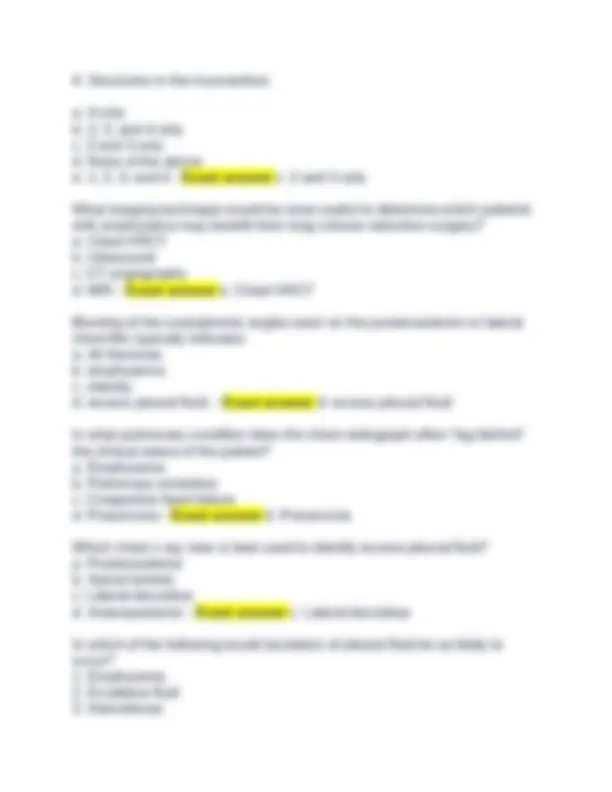
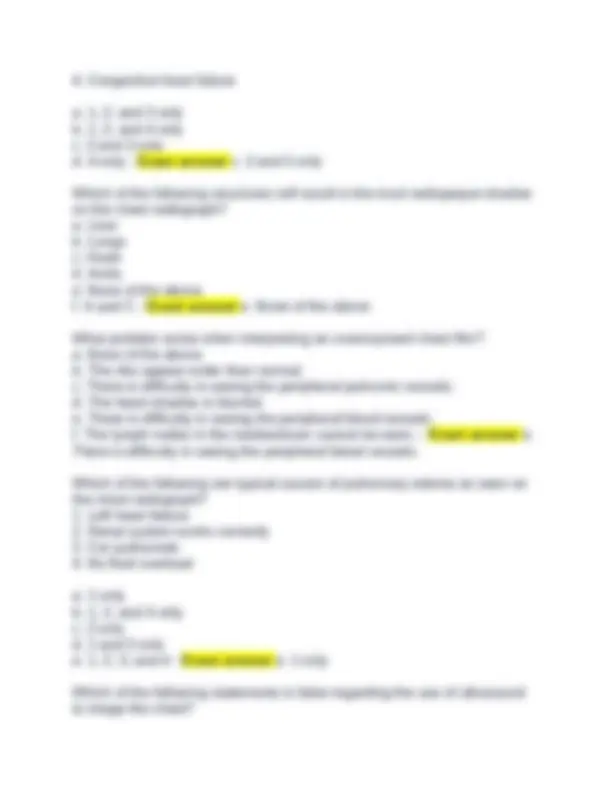
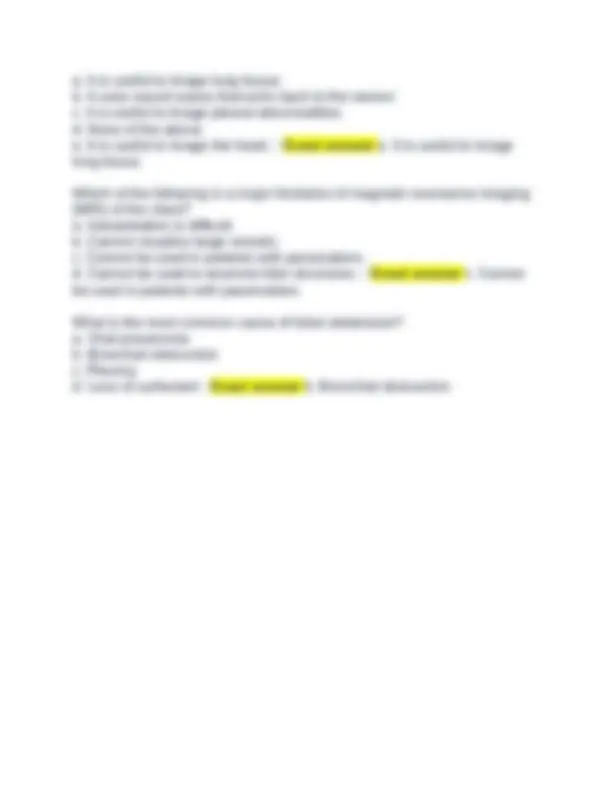


Study with the several resources on Docsity

Earn points by helping other students or get them with a premium plan


Prepare for your exams
Study with the several resources on Docsity

Earn points to download
Earn points by helping other students or get them with a premium plan
Community
Ask the community for help and clear up your study doubts
Discover the best universities in your country according to Docsity users
Free resources
Download our free guides on studying techniques, anxiety management strategies, and thesis advice from Docsity tutors
DIAGNOSTICS FINAL TEST PRATICE QUESTIONS WITH ANSWERS REVEALED
Typology: Exams
1 / 40

This page cannot be seen from the preview
Don't miss anything!

































Which of the following are true about invasive versus noninvasive monitoring?
Why is the radial artery the preferred site for arterial blood sampling?
If patient pain or anxiety occurs during arterial puncture, which of the following will probably occur? a. Hypoventilation b. Hyperventilation c. Hypoxemia d. Respiratory acidosis - Exact answer b. Hyperventilation Most pre-analytical ABG errors can be avoided by ensuring that the sample is which of the following?
d. properly obtained capillary blood can provide estimates of arterial pH and PCO2 levels. - Exact answer b. A capillary sample PO2 provides a fairly close estimate of actual arterial oxygenation. Warming a capillary bed to 42° C has which of the following effects?
c. 1, 2, and 3 d. 2 and 3 only - Exact answer a. 1 and 3 only To measure PCO2, blood gas analyzers use what electrode? a. Severinghaus b. White c. Sahn d. Clark - Exact answer a. Severinghaus The advantage that point-of-care testing has over traditional laboratory testing is that point-of-care testing: a. utilizes equipment that is less expensive. b. reduces turnaround time. c. does not require trained personnel to run the tests. d. is more accurate than traditional laboratory testing. - Exact answer b. reduces turnaround time You must immediately begin monitoring the oxygenation status of an infant admitted to the emergency department in severe respiratory distress. Which of the following approaches would you select? a. Transcutaneous monitoring (PtcO2) b. Intraarterial optode monitoring c. Arterial puncture (PaO2) d. Pulse oximetry (SpO2) - Exact answer d. Pulse oximetry (SpO2) To avoid thermal injury with transcutaneous blood gas monitor sensors, what should you do?
What is the measurement of CO2 in respiratory gases called? a. Optometry b. Barometry c. Oximetry d. Capnometry - Exact answer d. Capnometry At the very beginning of exhalation, the PETCO2 normally should be at what level? a. 15 mm Hg b. 40 mm Hg c. 0 mm Hg d. 25 mm Hg - Exact answer a. 15 mm Hg During a single-breath capnogram, what does the occurrence of a plateau indicate? a. Exhalation of mainly dead space gas b. Inspiration of fresh respiratory gas c. Exhalation of mixed alveolar and dead space gas d. Exhalation of mainly alveolar gas - Exact answer d. Exhalation of mainly alveolar gas During a single-breath capnogram, the sharp downstroke and return to baseline that normally occurs after the end-tidal point indicates what? a. Inspiration of fresh respiratory gas b. Exhalation of mainly dead space gas c. Exhalation of mainly alveolar gas d. Exhalation of mixed alveolar and dead space gas - Exact answer a. Inspiration of fresh respiratory gas After changing the FiO2 of a patient with emphysema, how long should you wait to draw an ABG to monitor the patient's respiratory status? a. 10 to 20 min b. 20 to 30 min c. 30 to 40 min d. 5 to 10 min - Exact answer b. 20 to 30 min A run of three or more PVCs should be called: a. ventricular fibrillation. b. supra ventricular tachycardia. c. atrial tachycardia.
d. ventricular tachycardia. - Exact answer d. ventricular tachycardia. Which of the following is a potential complication for a patient with atrial fibrillation? a. Blood clot formation b. COPD c. Renal failure d. Asthma - Exact answer a. Blood clot formation What term is used to define the ability of certain cardiac cells to depolarize without stimulation? a. Polarization b. Autopolarization c. Automaticity d. Contraction - Exact answer c. Automaticity What structure normally paces the healthy heart? a. Bundle of His b. Atrioventricular (AV) node c. Sinoatrial (SA) node d. Purkinje fibers - Exact answer c. Sinoatrial (SA) node What structure serves as the backup pacemaker for the heart? a. Purkinje fibers b. Atrioventricular (AV) node c. Bundle of His d. Sinoatrial (SA) node - Exact answer b. Atrioventricular (AV) node Why is the electrical impulse temporarily delayed at the atrioventricular (AV) node? a. To allow more sodium buildup in the myocardial cells b. To allow better filling of the ventricles c. To allow complete emptying of the ventricles d. To allow complete filling of the atria - Exact answer a. To allow more sodium buildup in the myocardial cells At what part of the cardiac conduction system does the electrical impulse travel most rapidly? a. Intraatrial pathways b. Bundle branches
a. Cardiac contraction rate b. Voltage c. Blood flow d. Time - Exact answer b. Voltage The QRS of an ECG falls on a dark vertical line of the ECG paper. Subsequent QRS complexes fall on every other dark line (10 mm apart). What is the ventricular rate? a. 200/min b. 150/min c. 100/min d. 300/min - Exact answer b. 150/min What is suggested by inverted T waves on the ECG? a. Ventricular hypertrophy b. Myocardial ischemia c. Atrial enlargement d. Dextrocardia - Exact answer b. Myocardial ischemia Which of the following clinical conditions are associated with tachycardia?
b. Right-axis deviation c. First-degree heart block d. Third-degree heart block - Exact answer c. First-degree heart block What type of medications may lead to first-degree heart block? a. Bronchodilators b. Beta blockers c. Corticosteroids d. Xanthines - Exact answer b. Beta blockers Which of the following criteria applies to third-degree block? a. The ventricular rate is twice that of the atrial rate. b. The PR interval becomes progressively longer. c. The QRS complex is inverted compared to the P wave. d. There is no relationship between the P waves and the QRS complexes. - Exact answer d. There is no relationship between the P waves and the QRS complexes. For which of the following arrhythmias would an electronic pacemaker be indicated? a. First-degree block b. Third-degree block c. Sinus tachycardia d. Ventricular fibrillation - Exact answer b. Third-degree block On inspection of an ECG rhythm strip from an adult patient, you notice the following: regular sawtooth-like waves occurring at a rate of 280/min and a regular ventricular rhythm occurring at a rate of approximately 140/min. What is the most likely interpretation? a. Ventricular fibrillation b. Ventricular tachycardia c. Atrial fibrillation d. Atrial flutter - Exact answer d. Atrial flutter A patient who has been diagnosed with myocardial infarction is getting an ECG. The ECG trace shows a series of nonconducted P waves followed by a P wave that is conducted to the ventricles. The ratio of nonconducted to conducted P waves is fixed at 4:1. What plan for treatment should this patient receive?
c. 5.5 L/sec d. 8.0 L/sec - Exact answer a. 9.5 L/sec What pulmonary function test presents the highest risk for fainting? a. Maximum voluntary ventilation b. Total lung capacity c. Tidal volume per minute d. Slow vital capacity - Exact answer a. Maximum voluntary ventilation While checking the accuracy of a portable spirometer for volumetric measures with a calibrated super syringe, you obtain a mean measured value of 2.7 L. What is the percent error of this instrument? a. 90% b. 1% c. 30% d. 10% - Exact answer d. 10% Which of the following measure is typically increased in patients with restrictive lung disease? a. Lung volumes b. Pressure needed to expand the lung c. Airway resistance d. Lung compliance - Exact answer b. Pressure needed to expand the lung During a helium dilution test for functional residual capacity, you notice that it takes 19 min for equilibration between the gas concentrations in the spirometer and the patient's lungs. Based on this information, what can you conclude? a. The patient has obstructive lung disease. b. Insufficient oxygen was added to the system. c. The spirometer is leaking helium. d. The patient has restrictive lung disease - Exact answer a. The patient has obstructive lung disease. Comprehensive quality assurance of pulmonary function testing consists of which of the following:
b. 2, 3, and 4 only c. 4 only d. 1 and 4 only - Exact answer a. 2 and 3 only What shape of the flow-volume loop is typical for the patient with a fixed upper airway obstruction? a. Elliptical b. Box c. Circular d. Ramp - Exact answer b. Box You perform a series of pulmonary function tests on a patient with a potentially infectious disease carried via the airborne route. Which of the following infection-control procedures should you implement?
d. the sum of the pressures between the ends of the airway divided by the flow rate of gas moving through the airway. - Exact answer b. the pressure difference between the ends of the airway divided by the flow rate of gas moving through the airway. How can you ensure reliability when measuring the expiratory reserve volume (ERV)? a. Have the patient perform the maneuver until he or she becomes fatigued, and then take the last value. b. Have the patient perform the maneuver twice, ensure consistency, and then take the best value. c. Have the patient perform the maneuver three times, and then take the last value. d. Have the patient perform the maneuver twice, ensure consistency, and then take the mean value. - Exact answer b. Have the patient perform the maneuver twice, ensure consistency, and then take the best value. In which of the following conditions is total lung capacity (TLC) always reduced? a. Acute airways obstruction b. Restrictive lung disease c. Obstructive lung disease d. Combined restrictive and obstructive disease - Exact answer b. Restrictive lung disease What is the ability of a measuring device to consistently provide the same measure of the same quantity? a. Linearity b. Precision c. Capacity d. Accuracy - Exact answer b. Precision What would you use to determine the accuracy of a water-sealed spirometer in measuring lung volumes? a. Computer-generated flow patterns b. Standard subject with known volumes c. Calibrated 3-L syringe d. Calibrated high-flow flowmeter - Exact answer c. Calibrated 3-L syringe